
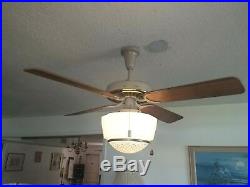
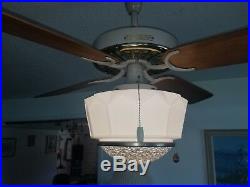
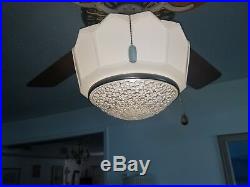
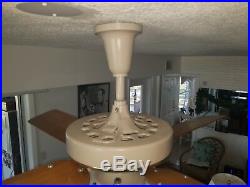
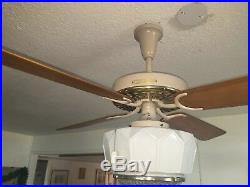
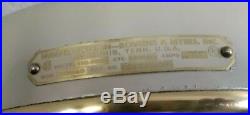
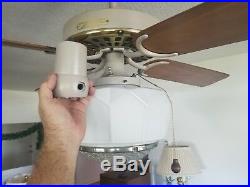
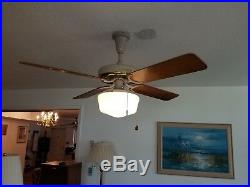
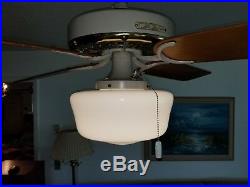
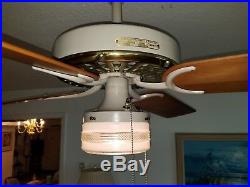

Brand New 60 yr old Hunter Ceiling Fan with Art Deco 6 Light Fitter 3 Speed (more photos below) Art Deco Globe shown not included. Chances are you will never see it again in this lifetime. We pulled this from the original box and touched up minor scuffs and scratches on the paint. If your home was built during the 1940’s, 1950’s or 1960’s this is the original style ceiling fan that would have been installed when new. While most appliances have improved since then, the Hunter Ceiling Fans have not. In fact, they are now made in China, they will not endure for decades as your home will. Why not put in the original style fan made in America that is Lifetime Guaranteed. If your home is in Tennessee (or even if you were simply born there) where this fan was made, you could take extra pride in that as well. Here is the youtube link. Some clues on Dating a Hunter Fan. If it says made in Tennessee it is after 1946. If it Says Robins & Myers it is after 1949. If it has no serial number it is after 1959. This fan came from a box marked R52. R52 fans were made between 1940 and the 1960’s. It also came with the inverted tulip shaped METAL switch housing which is prior to the 1970’s. It also features a NON-Capacitor shaded pole motor that uses a speed coil to change speeds. There is no capacitor to wear out. These are the same style Hunter motors made from 1906 to about 1986 that made Hunter Famous. Based on all the above we estimate the fan to be around 1960. ADVANTAGES OF SP SHADED-POLE VS THE PSC Permenite Split Capacitor. SP has far more torque than PSC. SP is more reliable than PSC, since capacitors blow out from time to time. We have SP fans still running after 100 years, whereas the PSC have only been out 35 years, so it is not as time tested as the SP motor. The Art Deco light globe could go back as far as the C17 (1917) over 100 years ago. The mount is called a 6″ fitter, but the width is 12″ and the depth is 9. It is all glass. It has a chrome band that allows the crystal bottom to come loose for easy bulb changing. I think they switched over to the 4 in the 1960’s so we are guessing at least 60 perhaps 90 years old. Mounting Options for lower ceilings under 8. In my room shown the ceiling is 7’8. It hangs down 28 from the ceiling. There is about 5’8 clearance. However, it is hung directly under the couch so nobody could walk into it anyway and it looks great in the room as a centerpiece. The same would apply if over a desk or coffee or dining table. Another way to add clearance is to use the modern vintage ceiling canopy instead of the tall original shown. This can be ordered in white, brass or we can match the tan paint shown, this will allow a shorter down rod of 3″ giving you 3″ additional. With a low ceiling of 7’8″ this would allow 5’11” clearance with the art deco globe. Option 3 Use the standard “School House” Globe to allow 5’11” or 6’2″ with the modern shorter canopy and downrod. Small mini globe shown will add 8″ of clearance to total 6’4″ or 6’7. With the modern shorter canopy and downrod. Should you wish to have more clearance the normal “inverted tulip” switch housing replaces the light fitter and allows for 6’5″ clearance, or 6’8″. Mounting Options for higher ceilings over 8′. Using Standard 3/4 pipe from Home Depot you will find several lengths with the required threading already on both ends to whatever length you wish to mount the fan. Simply use spray paint to match the color of the fan for a professional finish. These fans are so powerful that even at 10 feet in the air, it will move the air at floor level. Downrods are available in stock on the shelf in the following lengths at Home Depot: 1 Foot, 1.5 Foot, 2 Feet, 2.5 Feet, 3 Feet, 3.5 Feet, 4 Feet, 4.5 Feet, 5 Feet, 6 Feet, 8 Feet, 10 Foot and 12 Feet. Any size in between can be made by cutting length to size and threading both ends for free at Home Depot. NO COST OPTIONS : We can switch the standard blade arms with Brass Adaptair blade arms that can reverse the air flow in either direction. We can also switch the canopy with a Brass one in either the long original style or the modern shorter style. Same goes with the mounting hardware, the original hook or the modern hook/bracket style. I will honor the original 5-year guarantee if this fan should ever fail under normal use. This fan uses the same oil bath lubrication system as all Hunters for the past 110 years. It takes just 1oz of standard 10 weight Hunter Oil and should be checked every 5 years. Under normal use, most people go 10 years without adding. The manual says it can also use 20 weight. Feel free to contact Jacob with any questions eight one three 5 O 6 O 7 6 2. Track Page Views With. Auctiva’s FREE Counter. The Memphis-based company produces more than 300 residential, commercial, and industrial ceiling fan models under such names as the 1886 Limited Edition, the Hunter Original, the Seville, and the Fantasy Flier. Accounting for nearly one percent of the room air conditioner market, Hunter has manufacturing operations in Memphis as well as in Mexico and the Far East. The Hunter Fan Company was founded in 1886 in Syracuse, New York, by James C. Hunter and his father, John Hunter, immigrants from Ireland. Originally known as the Hunter Fan and Ventilating Company, the fledgling business first engaged in the manufacture of water motors and meters. The founders expanded their operations to include the production of belt-driven fans, the power for which was first provided by water motors and later by the Tuerk Electric Motor, which they developed. The Hunter reputation for quality was established early in the company’s history: some of these earliest belt-driven fans are still in use today after more than a century. In 1889 the growing company moved its operations to Fulton, New York, where it would spend the next fifty years at a plant located at Front Street, extending from Huling Street to Tolbot Street. Twelve years later, upon the death of John Hunter, his six sons incorporated the company and focused their attention on expanding the production of ceiling fans. By the early 1920s, the company was widely known for its high-quality electric fans. Noted for their elaborate “Dragon” design, the electric fans were best suited for ceilings from ten feet and up and were advertised as ready for electric lights. By the early 1920s the Hunter name was widely known throughout the United States and the world. The fans were especially popular in India and China, and throughout the Far East, where thousands were exported each year. By the mid-1920s, desk oscillating fans had been added to the Hunter product line. In 1936, after purchasing the fan division of Century Electric Company, Hunter began manufacturing large pedestal air circulating fans and direct exhaust fans as well, which were used by many of the finest hotels and stores. Two years later, the company began producing attic fans as well. With the onset of World War II, the company suspended the manufacturing of ventilating equipment for consumer use and concentrated its efforts on aiding the war effort, producing belt fans for government use in Army hospitals and barracks, and portable ventilators and oscillators for the Navy. With the postwar boom in the U. Economy, Hunter expanded its operations to keep up with the growing need for commercial and industrial ventilating equipment. In 1946 the company moved its plant from Fulton to its present location in Memphis in order to take advantage of the rapid industrial expansion of the South. Three years later, Hunter was acquired by Robbins & Meyers, Inc. For the next 45 years, Hunter operated as a wholly owned subsidiary of Robbins & Meyers, producing a complete line of residential, commercial, and industrial fans. Although Hunter performed consistently well throughout the 1960s and 1970s, by the mid-1980s the company’s limited line of ventilating products, combined with the entrance of a number of new competitors into the market, brought on financial crisis. Clouspy, who took over as company chairman and chief executive officer. During the two years following the takeover, the management team guided the company through the financial crisis, developing a strategy of product diversification that made Hunter profitable once again. Solidifying its financial base by refinancing its remaining debt, Hunter was now in position to expand its operations through acquisition. A designer and importer of residential lighting products. In June 1987, the company went public under the name Hunter-Melnor, Inc. The company’s renewed success was attributed in part to the management style of Clouspy and his colleagues, who opted for a highly decentralized team of four presidents, each responsible for one division of the company. As Hunter was expanding its operations during this period, the company again underwent an organizational change. In 1988, just a year after it had gone public, the company was privatized through a leveraged buyout led by the investment firm Leach McMicking. The transition, however, did not impede the turnaround of the company. Boosted by the strong performance of the Melnor group and its line of garden chemical products, the Hunter group was able to take advantage of the expanding fan market, landing four new major customers: Payless Cashways, Kmart, Wal-Mart, and Target. Fan sales, once limited primarily to the South, had extended throughout the nation. While Miami, for instance, represented Hunter’s top sales city in 1984, Phoenix headed the list in 1987, followed by Philadelphia and Chicago. Driven by these forces, fan sales jumped from 1.2 million units in 1980 to 16 million in 1987, the company’s one-hundredth year of operation. As Hunter-Melnor, led by president and chief executive officer G. Competing in a market driven by such volatile factors as the weather, new home construction, and remodeling, Hunter and the rest of the industry were especially vulnerable to the recessionary economy of the late 1980s and early 1990s. Nevertheless, Hunter continued its pattern of growth by focusing on the remodellingsegment of the industry, where the demand for its upscale units represented the greatest potential for profit. While these strategies kept Hunter-Melnor at the forefront of the industry, the company’s profitable Hunter division was weighted down by debt affecting the entire company. To alleviate this problem and make each division bear the responsibility for its own debt, Hunter-Melnor was divided into two corporations in September 1991. Under the reorganization plan, Robert Beasely took over as the new president and chief executive officer of Hunter Fan. Kenroy International was placed under its control as a subsidiary. Less encumbered by debt, Hunter Fan was able to direct its attention and resources to advertising and product development. While continuing to emphasize the home fashion aspect of its ceiling fans, adding such models as the Fantasy Flier–a fan replica derived from a naval archival drawing of an F4U fighter plane&mdashø its product line, Hunter Fan launched the largest advertising campaign in the history of the industry. The company set the stage for its aggressive strategy in the summer of 1992 by reformatting its logo across all of its product lines, incorporating a new Hunter green color and introducing upscale packaging graphics. Starting in May 1993, the company began advertising a wide variety of its ceiling fans in 30-second prime time television spots and in such popular magazines as Newsweek and Sports Illustrated, in which two-page, four-color spreads appeared. The unprecedented advertisements emphasized both the multipurpose dimension of ceiling fans, showing their effectiveness in areas as diverse as the bathroom and the porch, and the economical advantages of the product, making the case that fans are a cost-effective alternative to air conditioning. In the summer of 1993, the company introduced more than a hundred new lighting fixtures, including models featuring weathered metal, colored glass, and textured finishes, strengthening its reputation as the leading supplier of upscale decorative fans. In October of that same year, the company added another potentially profitable market to its repertoire when the United States Food and Drug Administration approved its air purifiers as Class II medical devices. Accordingly, the company launched a national print ad campaign targeting consumers with ads in magazines such as Ladies Home Journal, Reader’s Digest, and Modern Maturity. Perhaps the company’s most innovative and publicized campaign began in February 1995, seven months into a major league baseball strike. Going against conventional wisdom, Hunter Fan unveiled a baseball-themed ceiling fan and introduced a nationwide “Why I Love Baseball” program, calling for baseball fans to write letters explaining why they cherish the national pastime. As an added incentive to the fans, the company awarded trips to the Baseball Hall of Fame in Cooperstown, New York, and ceiling fans to winners of the contest, which was judged by such well-known baseball fans as filmmaker Ken Burns, Sporting News editor John Rawlings, and the “Clown Prince of Baseball, ” Max Patkin. Instead of proving a liability, the strike actually succeeded in generating widespread interest in the contest and in the novelty item. With more than 225 U. Radio stations and a host of television stations and major publications covering the campaign, Hunter Fan was able to reap benefits from what may have first appeared to be a marketing disaster: in just the first few weeks of the campaign, the baseball fan became one of the company’s leading sellers. Behind the strength of its bold marketing strategy, Hunter Fan has entered its second century of operation well positioned for continued expansion. How far past this level the company will go depends largely on the state of the U. Construction market, the success of new competitors to the industry, and the height of the mercury on the thermometer. The item “Antique New 60 yr old Hunter Ceiling Fan Art Deco Light MADE IN TENNESSEE USA” is in sale since Saturday, January 19, 2019. This item is in the category “Home & Garden\Lamps, Lighting & Ceiling Fans\Ceiling Fans”. The seller is “jj-do-it-products” and is located in Tampa, Florida. This item can be shipped to United States, Canada, United Kingdom, Denmark, Romania, Slovakia, Bulgaria, Czech republic, Finland, Hungary, Latvia, Lithuania, Malta, Estonia, Australia, Greece, Portugal, Cyprus, Slovenia, Japan, China, Sweden, South Korea, Taiwan, South africa, Thailand, Belgium, France, Hong Kong, Ireland, Netherlands, Poland, Spain, Italy, Germany, Austria, Bahamas, Israel, Mexico, New Zealand, Singapore, Switzerland, Norway, Saudi arabia, United arab emirates, Qatar, Kuwait, Bahrain, Croatia, Malaysia, Brazil, Chile, Colombia, Costa rica, Panama, Barbados, Bermuda, Bolivia, Guadeloupe, Cayman islands, Sri lanka, Luxembourg, Maldives, Oman, Viet nam, Uruguay.
- Model: 23854A
- Color: brass
- MPN: Does Not Apply
- Brand: Hunter
- Material: Brass
- Fan Width: 52″
- EAN: Does not apply
- Room: ANY



